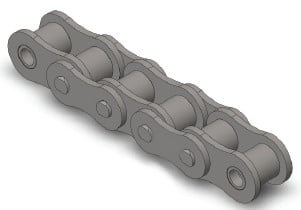The next steps really should be used to pick chain and sprocket sizes, ascertain the minimum center distance, and calculate the length of chain needed in pitches. We are going to mainly use Imperial units (such as horsepower) within this section even so Kilowatt Capability tables can be found for every chain dimension in the preceding area. The variety system is definitely the similar regardless with the units used.
Stage one: Ascertain the Class on the Driven Load
Estimate which of the following very best characterizes the problem from the drive.
Uniform: Smooth operation. Tiny or no shock loading. Soft start up. Reasonable: Normal or reasonable shock loading.
Hefty: Significant shock loading. Frequent starts and stops.
Stage 2: Ascertain the Support Component
From Table one below figure out the acceptable Service Aspect (SF) to the drive.
Phase 3: Calculate Design Electrical power Requirement
Style and design Horsepower (DHP) = HP x SF (Imperial Units)
or
Style and design Kilowatt Energy (DKW) = KW x SF (Metric Units)
The Style and design Power Requirement is equal to the motor (or engine) output energy times the Services Aspect obtained from Table one.
Stage four: Create a Tentative Chain Assortment
Produce a tentative collection of the demanded chain size inside the following method:
one. If working with Kilowatt power – fi rst convert to horsepower for this step by multiplying the motor Kilowatt rating by one.340 . . . This is certainly required because the brief selector chart is shown in horsepower.
two. Locate the Design and style Horsepower calculated in stage three by studying up the single, double, triple or quad chain columns. Draw a horizontal line by this value.
3. Locate the rpm in the small sprocket around the horizontal axis from the chart. Draw a vertical line by 
four. The intersection on the two lines should indicate the tentative chain choice.
Step five: Pick the amount of Teeth for that Tiny Sprocket
When a tentative variety of the chain dimension is produced we have to figure out the minimum variety of teeth demanded on the smaller sprocket required to transmit the Layout Horsepower (DHP) or the Design and style Kilowatt Electrical power (DKW).
Stage six: Establish the quantity of Teeth to the Large Sprocket
Utilize the following to determine the number of teeth for that big sprocket:
N = (r / R) x n
The amount of teeth to the significant sprocket equals the rpm of your small sprocket (r) divided from the wanted rpm of the large sprocket (R) instances the quantity of teeth around the tiny sprocket. When the sprocket is also substantial to the room readily available then several strand chains of the smaller sized pitch should be checked.
Stage seven: Identify the Minimal Shaft Center Distance
Utilize the following to determine the minimum shaft center distance (in chain pitches):
C (min) = (2N + n) / six
The above is really a guidebook only.
Stage eight: Test the Last Assortment
In addition bear in mind of any likely interference or other area limitations that could exist and adjust the selection accordingly. Normally quite possibly the most efficient/cost eff ective drive utilizes single strand chains. This is often since many strand sprockets are more high priced and as is often ascertained from the multi-strand things the chains come to be much less effi cient in transmitting power as the quantity of strands increases. It’s as a result commonly most effective to specify single strand chains anytime feasible
Stage 9: Identify the Length of Chain in Pitches
Make use of the following to calculate the length in the chain (L) in pitches:
L = ((N + n) / 2) + (2C) + (K / C)
Values for “K” might be located in Table four on web page 43. Remember that
C is the shaft center distance given in pitches of chain (not inches or millimeters and so forth). If the shaft center distance is acknowledged within a unit of length the worth C is obtained by dividing the chain pitch (inside the similar unit) from the shaft centers.
C = Shaft Centers (inches) / Chain Pitch (inches)
or
C = Shaft Centers (millimeters) / Chain Pitch (millimeters)
Note that when probable it is most effective to make use of an even amount of pitches in an effort to steer clear of the use of an off set website link. Off sets don’t possess the same load carrying capability as the base chain and must be avoided if possible.
